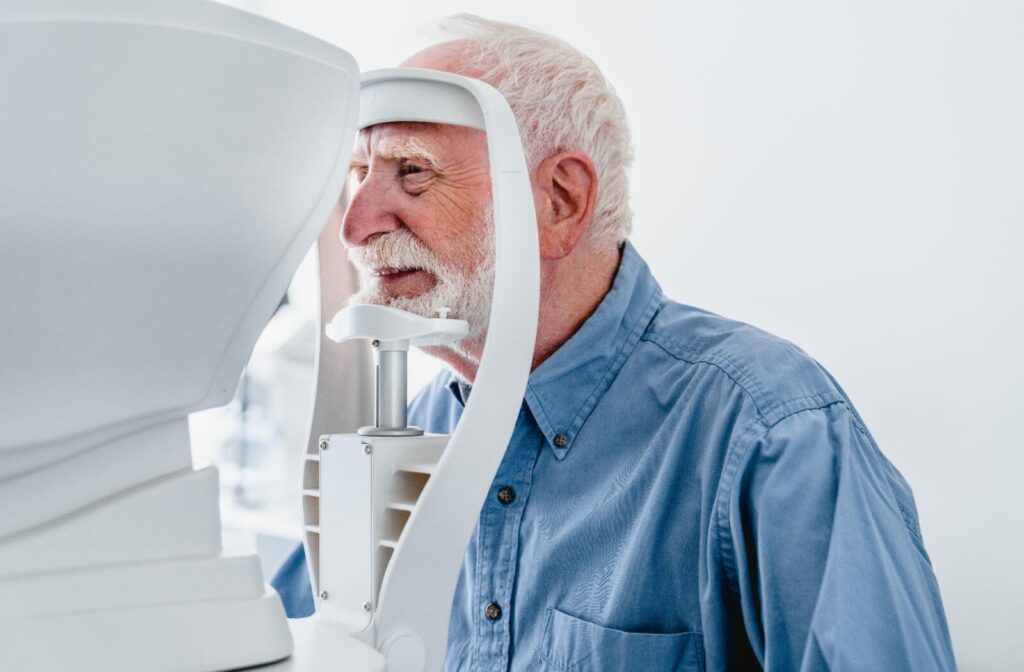If you are finding it harder to enjoy your favorite book or struggling to see clearly at night, you may be experiencing some of the earlier signs of cataracts or glaucoma. These eye conditions become increasingly common as we age and can significantly impact our quality of life if not addressed promptly.
Some cataract symptoms you may notice include hazy vision, light sensitivity, and faded colors. Meanwhile, glaucoma symptoms include peripheral vision loss, halos around lights, and sometimes even eye pain. These symptoms can seem to come out of nowhere, but by having regular eye exams, we can watch for small changes and take action immediately.
What Are Cataracts?
Cataracts create a cloudy film over your vision, due to natural aging changes to the crystalline lens located behind the iris and pupil. Imagine trying to look through a foggy window—that’s what cataracts do to your vision. This is a natural part of aging. Over time, the proteins in the lens break down and clump together, decreasing the quality of our vision.
So, who is more likely to develop cataracts? While everyone develops them with advanced age, certain factors make it more likely sooner. These factors include:
- Smoking
- Heavy alcohol consumption
- Sun exposure
- Eye injuries, eye surgery, or radiation treatment
- Medical conditions like diabetes
- Steroids
Also, if your parents or siblings have cataracts, especially at an earlier age, you may be more prone, genetically, to develop them as well.
Cataracts develop slowly, and many people don’t notice the changes in their vision at first. As they get worse, however, they can really interfere with things, such as reading, driving, and even recognizing faces. Staying informed can help us deal with it earlier and better.
Recognizing Cataract Symptoms
Recognizing the symptoms of cataracts early can lead to timely treatment and better outcomes. Here are some common signs to watch for:
Blurred Vision
One of the most noticeable symptoms of cataracts is blurred or cloudy vision. It might feel like you are looking through a cheesecloth, which can affect your ability to read or see details clearly.
Sensitivity to Light
People with cataracts often experience increased sensitivity to light and glare. Bright sunlight or indoor lights can cause discomfort or even pain. You may also notice halos around lights, making night driving particularly challenging.
Faded Colors
Cataracts can cause colors to appear faded or yellowed. This change in color perception can be subtle at first but becomes more noticeable over time. You may find it harder to distinguish between similar shades.
Other Symptoms
Other signs of cataracts that you may notice include:
- Poor night vision
- Double vision
- Rapidly changing eyeglass prescription
What Is Glaucoma?
Glaucoma is an eye disease that damages the optic nerve, causing it to appear more cupped. Most forms of glaucoma involve increased eye pressures (although not always the case), which is why checking eye pressures is one of the most important tests performed during a comprehensive eye exam. As this pressure damages the optic nerve, you will slowly lose your peripheral vision before affecting your central vision. However, you may have increased eye pressure for a long time before you ever notice any symptoms—and by then, the damage and loss of vision are irreversible.
The main types of glaucoma are open-angle and angle-closure glaucoma. Open-angle glaucoma is the most common and progresses slowly, while angle-closure can happen suddenly and considered a medical emergency.

Recognizing Glaucoma Symptoms
Detecting glaucoma early can prevent severe vision loss, so it is important to recognize the symptoms:
Peripheral Vision Loss
The early stages of glaucoma typically affect peripheral vision first. You might notice that you cannot see objects out of the corner of your eye as easily as you used to. This change can be gradual and easy to miss, but we can measure it with visual field testing.
Seeing Halos Around Lights
This can be hard to spot if you are not looking for it, but people with glaucoma often see halos around lights, especially in dim lighting. This symptom is more common in angle-closure glaucoma but can occur in other types as well. It can make driving at night particularly difficult, as you may be blinded by oncoming headlights.
Eye Pain & Headaches
While angle-closure glaucoma can cause rapid vision loss when compared to open-angle glaucoma, its symptoms are also a bit more noticeable. The sudden spike in eye pressure can cause severe eye pain and headaches. If you notice this, seek immediate medical attention to prevent permanent vision loss.
Importance of Early Detection
We’ve said it before, and we’ll say it again. Early detection of cataracts and glaucoma is vital, and regular eye exams can identify these conditions before they cause significant damage and loss of vision. We have an arsenal of tests to check for cataracts, in addition to measure eye pressure, examine the optic nerve, and assess visual fields related to diagnosing, monitoring, and treating glaucoma.
Early detection means you can begin treatment sooner, slowing the progression of the disease and preserving your vision.
In the early stages, you may be able to manage cataracts with stronger eyeglasses or brighter lighting when reading. As they get worse, however, surgery becomes the preferred option. Cataract surgery, which removes the eye’s natural, cloudy lens and swaps it for an artificial, clear one, is common and safe.
Treating glaucoma focuses on lowering eye pressures to protect the optic nerve. We may recommend prescription eye drops, oral medications, laser treatments, or even surgeries. The appropriate choice depends on the type and severity of your glaucoma.
Keeping an Eye on Your Eye Health
If you have noticed any of the symptoms that we have mentioned above, do not hesitate to reach out. Our friendly team at Eye Love Optometry is here to help you keep your vision sharp and eyes healthy. Book an appointment today and take the first step in ensuring good eye health!
















